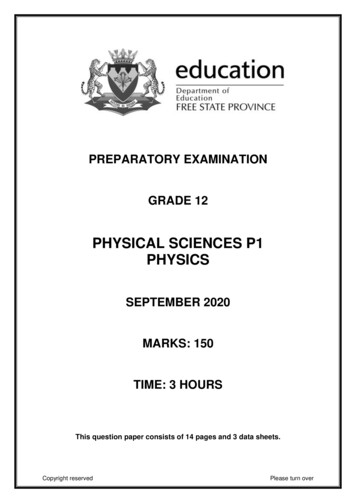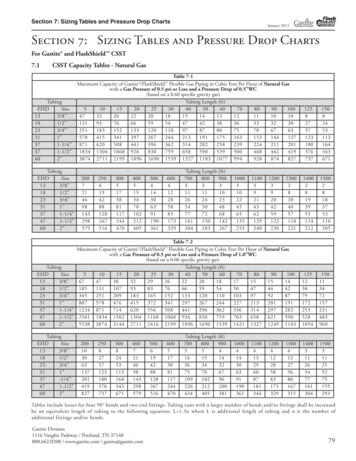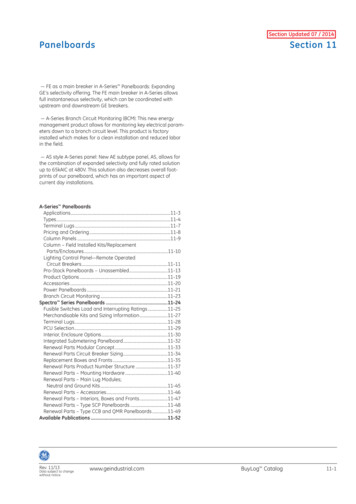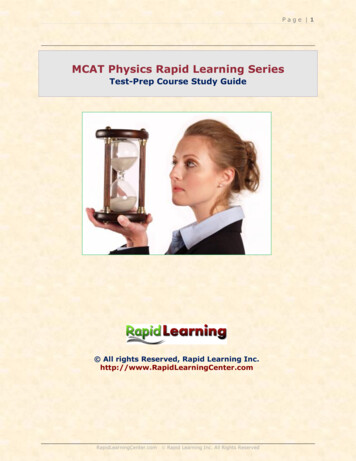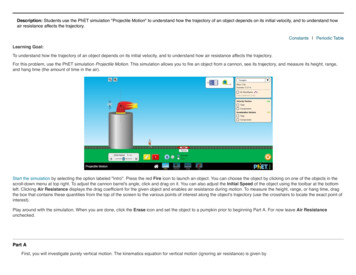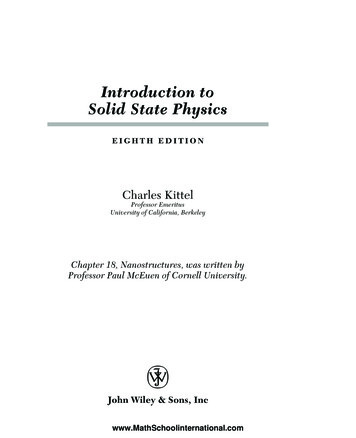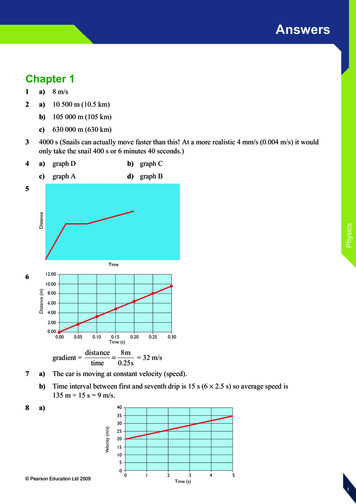
Transcription
AnswersChapter 11a)8 m/s2a)10 500 m (10.5 km)b) 105 000 m (105 km)c)630 000 m (630 km)34000 s (Snails can actually move faster than this! At a more realistic 4 mm/s (0.004 m/s) it wouldonly take the snail 400 s or 6 minutes 40 seconds.)4a)graph Db) graph Cc)graph Ad) graph Ba)distance8m 32 m/stime0.25sThe car is moving at constant velocity (speed).Physics56gradient 7b) Time interval between first and seventh drip is 15 s (6 2.5 s) so average speed is135 m 15 s 9 m/s.8a) Pearson Education Ltd 20091
b) Distance travelled is given by the area under the graph (5 s 20 m) (0.5 5 s 15 s) 137.5 m9a)Average speed is found by dividing the total distance a body has travelled by the time it hastaken; the speed may vary from moment to moment during this time. The instantaneous speed isthe speed at which the body is travelling at a moment in time.b) Speed is a scalar quantity – it is distance travelled divided by time without regard to direction.Velocity is a vector quantity – it is speed in a specified direction.10 4 m/s2Physics11 a)b)c)12 a)3 m/sb) 15 m/sc)13 a)75 m/sgraph Bb) graph Ac)graph Dd) graph C Pearson Education Ltd 20092
14152.5 m/s2b) i)20 mii)50 mc)average speed total distance travelled time taken. 70 m 9 sPhysicsa) 7.78 m/s16 The total distance travelled increases with the square of the time from the start, 0.5 m after 1 s, 2.0 mafter 2 s, 4.5 m after 3 s, etc. Calculating the average velocity over each 1 s time interval (betweenthe drips) and then plotting a graph of average velocity against time allows the acceleration to becalculated from the gradient of the graph. The acceleration is 1 m/s2.Chapter 21a)gravityb) frictionc)normal reaction or contact force2Friction and air resistance (or viscous drag)3a)1200 Nb) 1250 Nc)50 Nd) red4 Pearson Education Ltd 20093
56a)Without friction, objects would not be able to start moving from a stationary position, or stopmoving when in motion. It would not be possible to build things because it would be difficult topick up the building materials, and structures rely on friction to remain intact.Physicsb) Any two sensible examples, such as: walking would be impossible without friction actingbetween your feet and the ground; climbing a rope would be impossible without friction actingbetween your hands and the rope.7a)8a)b) Pearson Education Ltd 20094b)
9a)Load force on spring (newtons)Length of spring (cm)Extension of spring 2.97.9Physicsb) c) (d – red line)Chapter 31A force that is not balanced by a force in the opposite direction. An accelerating car has anunbalanced force when the forwards force from the engine is bigger than the backwards force fromair resistance.2From the equation force mass acceleration (F ma) we can see that if F, the thrust force of therocket engines, is constant and m, the mass of the rocket, decreases then the acceleration mustincrease.3a)F ma, where mass 0.5 kg and acceleration 4 m/s2So F 0.5 kg 4 m/s2 2 Nb) m F a, where force 200 N and acceleration 0.8 m/s2So m 200 N 0.8 m/s2 250 kgc)Use a F m, where force 250 N and mass 25 kgSo a 250 N 25 kg 10 m/s24By bending their legs and rolling on landing, parachutists extend the time over which their velocity isreduced to zero. This reduces the deceleration they undergo, and hence the forces that act on thebody. Reducing the forces that act reduces the chances of broken bones and other body damage.5a)Thinking distance is the distance a car travels after the driver has seen a hazard but before thedriver applies the brakes; during this period the car is not decelerating. Pearson Education Ltd 20095
b) The braking distance is the distance travelled by the car after the driver has started braking andthe car is decelerating to rest.c)The overall stopping distance is the sum of the thinking distance and the braking distance.6The braking distance of a car depends on the speed that the car is travelling and the braking forcethat can be applied without the car skidding (as skidding means the car is out of control). Themaximum braking force will be limited by factors that affect the friction between the car tyres andthe road surface: the condition of the tyres and the road surface – if the road surface is wet, icy oroily friction will be reduced. The braking distance is greater if either the speed of the car is higher orthe maximum safe braking force is reduced.7a)0.75 s (the period during which the velocity of the car is constant at 24 m/s)b) 18 m (given by the area under the velocity–time graph during the first 0.75 s)c)2.5 s (the period during which the velocity of the car is decreasing to zero)d) 48 m (the sum of the thinking distance and the braking distance – the total area under the graph)8a)Use weight mass gravitymass of apple in kg 0.1 kgstrength of gravity on the Earth is approximately 10 N/kgPhysicsweight of apple on the Earth 0.1 kg 10 N/kg 1 Nb) Use weight mass gravitymass of apple in kg 0.1 kgstrength of gravity on the Moon is approximately 1.6 N/kgweight of apple on the Moon 0.1 kg 1.6 N/kg 0.16 N9The factors affecting the drag force on a high speed train are: the speed of the train the shape of the train the direction of any wind that may be blowing (harder) the viscosity of the air that it is travelling through; this will depend on temperature,humidity, etc.10 See page 31 for description of a suitable experiment.11 At A: velocity is zero at start, so air resistance is zero and the unbalanced force is downwards (andis due to gravity or the weight of the parachutist).At B: as the velocity of the parachutist increases so does the size of the upward air resistance force –so the unbalanced downwards force is smaller.At C: here the velocity of the parachutist has increased to the point where the upward air resistanceforce is exactly the same as the downward force of gravity on the parachutist – the unbalanced forceis zero and the parachutist has reached terminal velocity.At D: the parachutist has opened her parachute at this time. This greatly increases the upward airresistance force so the unbalanced force on the parachutist is now upwards – so the parachutist’svelocity decreases. Pearson Education Ltd 20096
At F: as the parachutist slows down, the upward air resistance force due to the parachute decreases.This means that the unbalanced upward force is smaller. (So the rate of deceleration of theparachutist decreases.)At G: the parachutist has slowed to a velocity at which the upward acting air resistance is once againequal to the downward acting force of gravity. The unbalanced force is again zero. (But note thatthe effect of opening the parachute is to make the new terminal velocity lower.)Chapter 41All three examples use the formula momentum mass velocity.a)48 kg m/s2c)3 kg m/s (Remember to express the mass in kilograms and the velocity in m/s, thus:0.06 kg 50 m/s)a)In an elastic collision, the total kinetic energy of the colliding bodies is conserved, i.e.unchanged by the collision. Partially elastic and inelastic collisions (in which the collidingbodies coalesce or stick together) involve the conversion of kinetic energy into other forms, likeheat and sound.b) i)ii)3An example of an almost completely elastic collision is the collision of snooker balls(though some kinetic energy is converted to sound and heat). Collisions between themolecules in a gas are considered to be perfectly elastic.Physicsb) 150 000 kg m/sThrowing a wet sponge at your teacher at a charity event is an example of an inelasticcollision. A car driving into a wall and an egg hitting the ground are other examples.momentum before the collision momentum after the collisionmomentum of pellet momentum of truck at start momentum of truck with pellet after0.002 kg v 0 (truck is stationary) 0.102 kg 0.8 m/sSo the velocity, v, of the pellet is 40.8 m/s4impulse increase in momentum where impulse force timeimpulse 10 000 N 60 sSo the increase in momentum is 600 000 kg m/sincrease in momentum mass increase in velocitySo the increase in velocity 600 000 kg m/s 1200 kg 500 m/sThe new velocity is, therefore, 2500 m/s (initial velocity plus the increase in velocity).5When a mass, like a person in a crashing car, is brought rapidly to a halt, it is subject to a largedeceleration. This large deceleration means that the mass must be subject to a huge force. Largeforces result in damage. By building crumple zones into cars, the time that the car takes to come to ahalt is extended – this means that the deceleration, and therefore the forces that act during thedeceleration, are reduced. Pearson Education Ltd 20097
Chapter 51B has the largest turning moment, having the biggest force applied at the greatest perpendiculardistance from the pivot. D has a greater moment than C because the line of action of the 5 N force inC has a smaller perpendicular distance from the pivot. A shows the situation with the least turningmoment because the 10 N force is applied at a perpendicular distance from the pivot that is clearlyless than half the perpendicular distance of the line of action of the 5 N force in C.So B, D, C, A is the correct order.2a)C is balanced as the clockwise moment is equal to the anticlockwise moment.b) A tips down to the left, clockwise moment 25 Nm, anticlockwise moment 375 NmB tips down to the right, clockwise moment 400 Nm, anticlockwise moment 375 NmD tips down to the left, clockwise moment 350 Nm, anticlockwise moment 375 Nm3a)b) 5 N on each support (this answer ignores the weight of the shelf itself).Physicsc)The book is 43 of the way between P and Q.P supports 2.5 N and Q supports 7.5 N.14of its weight will be on P, and34on Q, sod) The forces due to the new book are 2.5 N on each support, so the total force on P is 5 N and thetotal force on Q is 10 N.e)The weight of the shelf is spread evenly along the shelf, so each support takes half the weight(5 N).So with one 10 N book in the middle of the shelf, there is 10 N on each support. With the book50 cm from Q, there is a force of 7.5 N on P and 12.5 N on Q.Chapter 61a)An asteroid is a rocky body, usually between several metres or several hundreds of kilometresacross, which is orbiting the Sun.b) A comet is a body composed of dust and ice, which orbits the Sun following a very ellipticalpath.c)Most asteroids have an orbit which lies between the planets Mars and Jupiter. The orbits ofcomets at times take them very close to the Sun and at other times to the outer reaches of theSolar System. Asteroids are composed of rocks. Comets are composed of ice and dust.d) Away from the Sun.e)2Comets move very quickly when they are close to the Sun, and much more slowly when theyare a long way from the Sun.The Milky Way is the name of our galaxy. Pearson Education Ltd 20098
3a)2π r(35786 6400) kmorbital speed 2π r , so T 2 π Tspeed3.07T 86340 sb) This is 24 hours, so the satellite completes one orbit in the same time as the Earth spins once. Ifthe satellite is over the equator, it is in a geostationary orbit.4orbital speed 2π rTIf you use distances in km and times in hours, the speeds you work out will be in km/h.a)radius of Earth’s orbit 150 million kmperiod of Earth’s orbit 1 year (which is 365.25 24 hours 8766 hours)speed 2 π 150 000 000 km8766 h 107 515 km/hb) radius of Jupiter’s orbit 5 radius of Earth’s orbit 750 million kmspeed 2 π Physicsperiod of Jupiter’s orbit 12 Earth years 105 192 hours750 000 000 km105192 h 44 798 km/hEnd of Section A questions1vector, shape, acceleration, mass, weight, terminal, balanced.moments, perpendicular, pivot.2a)(10)Speed is found from slope of graph(1) 60 m 30 s(1) 2 m/s(1 for correct answer with unit)b) Standing stillc)(1)Walking back to starting point quickly (1)or walking at –4 m/s (1 mark for sign, 1 mark for correct value, 1 mark for correct unit)d) Average velocity 60 m 45 s 1.3 m/s3a)Acceleration increase in velocity time taken(1)(1)(1) 150 m/s 5 s(1) 30 m/s2(1) Pearson Education Ltd 20099
b) Area under graph distance travelledc)4a)(1)Approximate to suitable shapes, e.g. triangle and trapezium(1)Calculate appropriate areas(1)Answer in range 6200 m to 6600 m(1)Average velocity total distance travelled time taken(1) value from above say 6400 m 30 s(1) 213 m/s(1)Use v u at, where u 0, a 9.8 m/s2 and t 30 sso speed, v, after 30 s 9.8 m/s2 30 s 294 m/s(1)(1)(2)The acceleration gets less as she gets faster, as the air resistance increases.(1)She slows down when the parachute opens because it increases her air resistance suddenly.(1)a)(1)Physicsb) Your graph should look similar to this:5Deceleration reduction in velocity time taken (40 m/s – 0 m/s) 10 s(1) 4 m/s2(1)b) Use F ma, so braking force, F 700 kg 4 m/s2 2800 N6a)(1)(1)(1) for each correctly identified force in the correct direction.b) There is no unbalanced force on the float (1); the sum of the forces acting on the float is zero (1)c)When the rope breaks there is a resultant upward force on the float (1) so it acceleratesupwards (1). Pearson Education Ltd 200910
7a)The moment of a force about a point is the product of the force (1) and the perpendiculardistance from the line of action of the force to the point.(1)b) Position five 0.1 N weights (1) on the hand, to the left of the centre of the hand (1), at a distanceof 0.1 m (10 cm) from the centre (1), thus:(2 marks for clearly labelled diagram)a)150 N at A (1) and 150 N at B (1)b) Total weight hanging on frame 650 NThey areso92313of the way from Aof the weight will be supported by A(1)(1)(1)so the force on A is 433 N(1)c)At A(1)a)Momentum mass velocity(2)b) Use total momentum before explosion total momentum after explosion.(1)Cannon and ball are stationary initially, so momentum before is zero.(1)Momentum of cannon ball
Answers Pearson Education Ltd 2009 1 1 1 Physics Chapter 1 1 a) 8 m/s 2 a) 10 500 m (10.5 km) b) 105 000 m (105 km) c) 630 000 m (630 km) 3 4000 s (Snails can actually move faster than this! At a more realistic 4 mm/s (0.004 m/s) it would only take the snail 400 s or 6 minutes 40 seconds.) 4 a) graph D b) graph C c) graph A d) graph B 5 6

